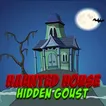









































Ghost Games: Exploring the Haunting Fascination with the Supernatural
Venturing into the realm of ghost games is akin to opening a creaky door to a dimly lit corridor, where every shadow whispers tales of the unknown. This segment of the horror genre is a unique concoction of suspense, mystery, and supernatural elements that beckon the brave and the curious alike. Ghost games are not merely about the scares; they are about the stories that linger, the puzzles that haunt the mind, and the eerie satisfaction of confronting the ethereal.
The broad appeal of ghost games is undeniable. They offer narrative-driven adventures for those who seek to unravel ghostly tales, and survival horror challenges for the ones thirsting for a pulse-pounding escape from spectral entities. The term “ghost game” is not just a label; it’s a portal to a world where the veil between the living and the dead is at its thinnest.
These games are a playground for the imagination, where every creak in the floorboards and every flicker of an extinguished candle can mean something more. The high search volume keywords “ghost game” and “ghost games” are a testament to our collective fascination with the supernatural. They reflect a longing to explore the unexplored, to feel the rush of fear, and to test the limits of our own bravery.
In a ghost game, players are not just passive observers but active participants in a haunting narrative. It’s a space where folklore and digital artistry intertwine, creating an experience that’s as captivating as it is chilling. Whether it’s the thrill of the chase or the chill of the encounter, ghost games have cemented their place in the hearts of those who dare to play with the paranormal.
Why Ghost Games Grip Our Imagination: The Psychology of Fear in Gaming
The allure of ghost games taps into the primal instinct of fear, a powerful emotion that has captivated human beings since time immemorial. It’s the psychology of fear that hooks players, drawing them into the spectral worlds where the line between reality and the supernatural blurs. The game ghost game becomes an exploration of the unknown, a digital dance with the macabre that both terrifies and entices.
Fear, in the controlled environment of games with ghosts, provides a thrill akin to riding a rollercoaster. The adrenaline rush, the heightened senses, and the quickened pulse all contribute to a visceral experience. This is the safe scare, where players can confront their fears head-on without real-world consequences, allowing them to revel in the exhilaration of survival against otherworldly odds.
The unknown is a critical component of this engagement. Ghost games often weave a narrative shrouded in mystery, compelling players to uncover hidden truths and face the intangible. It’s the not knowing, the anticipation of what might lurk around the next corner, that fuels the player’s imagination and keeps them coming back for more.
Moreover, ghost games serve as a playground for the psyche, where players can experiment with their boundaries of fear and confront the concept of death in a setting that is both fantastical and safe. This psychological interplay is what makes ghost games so gripping, as they offer an experience that is as much about understanding our own reactions to fear as it is about the game itself.
In essence, ghost games are a mirror to our psyche, reflecting our deepest fears and curiosities. They are a testament to the power of the human mind to find fascination within fear, and the unending allure of the ghostly realms that exist just beyond the veil of our reality.
The Art of Atmosphere: Designing the Ultimate Ghost Game Experience
Creating the ultimate ghost game experience is an intricate art that hinges on the mastery of atmosphere. The most haunting ghost games are those that craft an environment so immersive that players can almost feel the chill of the virtual fog on their skin. Setting is paramount; a decrepit mansion, an abandoned asylum, or a fog-laden graveyard can serve as the perfect backdrop for supernatural encounters. Each location is meticulously designed to amplify the sense of isolation and vulnerability, setting the stage for the spectral narrative to unfold.
Sound design is another critical element that breathes life into haunted ghost games. A soundtrack that features eerie whispers, the sudden, sharp clang of a distant bell, or the unsettling creak of a floorboard can make the heart race. It’s the careful layering of ambient sounds that creates a soundscape so realistic, players might pause the game just to reassure themselves that they are, indeed, still in the safety of their own homes.
Narrative is the final, and perhaps most compelling, piece of the ghost game horror puzzle. A well-told story can transform a simple game into an unforgettable journey. It’s the lore and legends woven into the gameplay, the carefully placed clues, and the slow unraveling of a ghostly mystery that keep players ensnared. The narrative drives the action, compels the exploration, and rewards the brave with revelations that are as satisfying as they are spine-tingling.
Together, these elements coalesce to form an experience that is more than just a game; it’s an invitation to step into a world where every shadow could conceal a ghostly presence, and every turn holds the potential for a haunting encounter. This is the essence of ghost gaming: an artfully crafted adventure that lingers long after the screen goes dark.
The Evolution of Ghost Games: Cultural Impact and Player Engagement
The fascination with ghost games is deeply rooted in our culture, reflecting our enduring interest in the supernatural and the macabre. As the gaming industry has evolved, so too have ghost games, growing from pixelated specters to fully realized phantoms haunting the digital landscapes of modern gaming. This evolution has not only pushed the boundaries of game development but also deepened player engagement, creating communities bound by a shared love of the thrill that comes from virtual hauntings.
Ghost games have become a canvas for storytelling, drawing on cultural myths and legends to craft narratives that resonate with players worldwide. The cultural impact is significant, as these games often explore themes of life, death, and what may lie beyond, prompting players to ponder their own beliefs and fears. This introspection, combined with the adrenaline of gameplay, creates a compelling, emotionally charged experience that keeps players coming back.
Player engagement goes beyond the screen, spilling into online forums, fan art, and even real-world ghost hunting inspired by the games they love. The term “game of ghost” encapsulates this phenomenon, where the lines between entertainment and personal identity begin to blur. Players are not just consumers; they are part of a larger narrative, contributing to the lore and legend of the ghost games they play.
The evolution of ghost games is a testament to our unquenchable curiosity about the unknown. As technology advances, these games will continue to captivate with ever-more immersive experiences, ensuring that the ghost gaming genre remains a vibrant and vital part of our cultural tapestry.